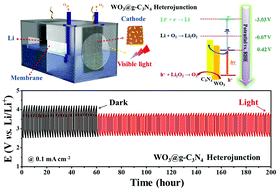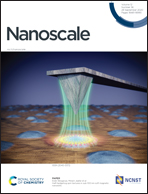Efficient separation of photoexcited carriers in a g-C3N4-decorated WO3 nanowire array heterojunction as the cathode of a rechargeable Li–O2 battery†
Abstract
Utilization of solar energy is very important for alleviating the global energy crisis; however, solar-to-electric energy conversion in a compact battery is a great challenge. High charging overpotential of conventional aprotic Li–O2 batteries still restricts their practical application. Herein, we propose a photo-involved rechargeable Li–O2 battery to not only realize direct solar-to-electric energy conversion/storage but also address the overpotential issue. In this photo-involved battery system, the g-C3N4-decorated WO3 nanowire array (WO3@g-C3N4 NWA) heterojunction semiconductor is used as both the photoelectrode and oxygen electrode. Upon charging under visible-light irradiation, the photoexcited holes and electrons are in situ generated on the WO3@g-C3N4 NWA heterojunction cathode. The fabrication of the heterojunction can distinctly reduce the recombination rate between electrons and holes, while photon-generated carriers are effectively and quickly separated and then migrate under a large current density. The discharge product (Li2O2) can be oxidized to O2 and Li+ with a reduced charging voltage (3.69 V) by the abundant photoexcited holes, leading to high energy efficiency, good cycling stability and excellent rate capability. This newly photo-involved reaction scheme could open new avenues toward the design of advanced solar-to-electric energy conversion and storage systems.



 Please wait while we load your content...
Please wait while we load your content...